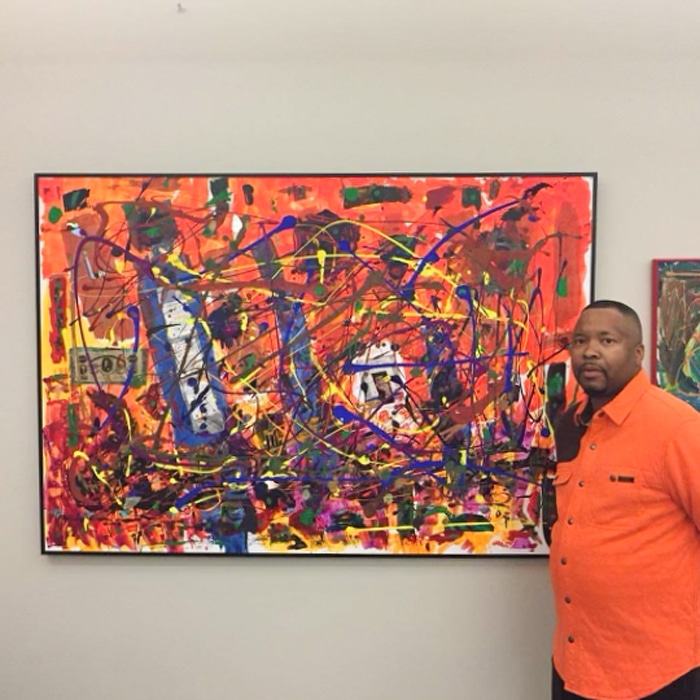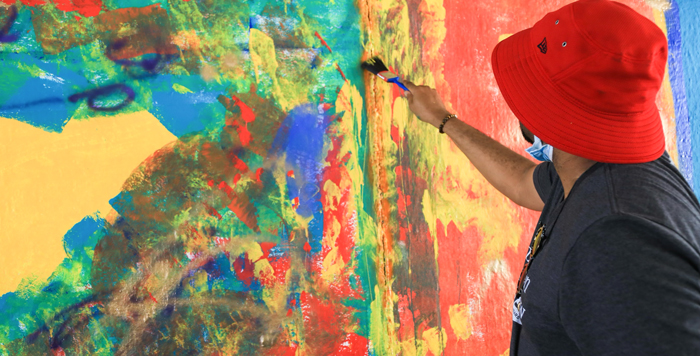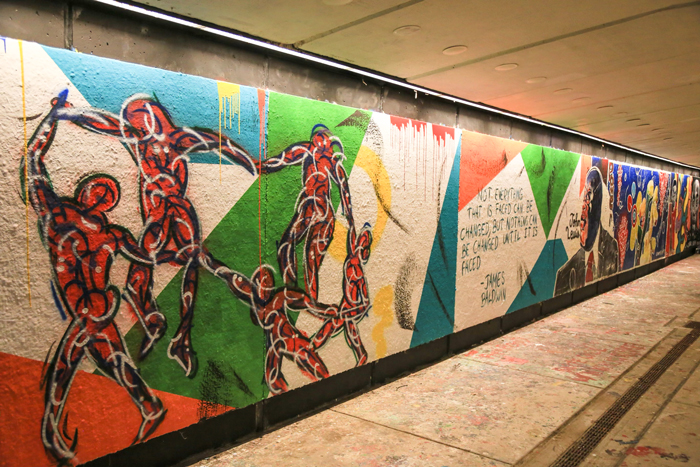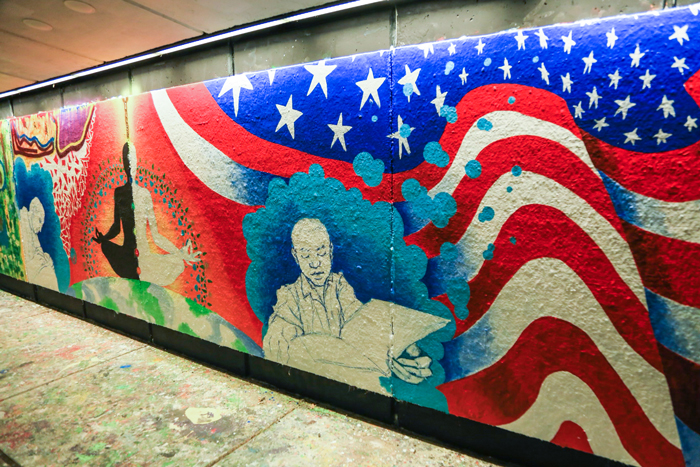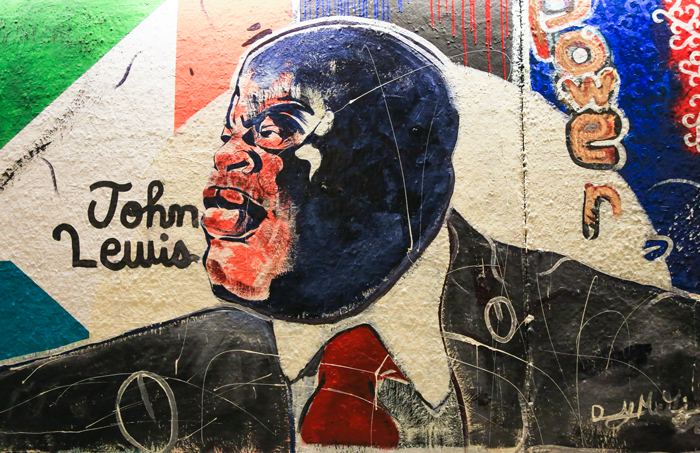After Patriot Front-linked Vandalism, a Black Artist Searches for Vindication
“It’s to be expected. St. Louis is the gateway of institutionalized racism, so you know, I call all my strength from the ancestors,” said St. Louis-based artist De’Joneiro Jones. “The ancestors are with me, and I will continue to talk about what happened, and tell the truth.”
The white nationalist group Patriot Front has been linked to the destruction of many artists’ work, including Jones’. As seen on Hatewatch’s recent Patriot Front timeline, in 2020 and 2021 the group allegedly destroyed or damaged more than 30 pieces of public art that represented famous Black Americans, Black and Brown victims of police violence, LGBTQ pride and feminist icons. Other public art targeted by Patriot Front honored Chicano and Hmong culture. With so much destruction, the psychological and emotional toll on a community and its people can be immense.
In Jones’ case, the toll is further compounded as a Black artist in St. Louis. Hatewatch investigated Jones’ experience after Patriot Front members allegedly destroyed his mural. Over the course of several conversations, Jones told Hatewatch about the impact of the vandalism, how Black artists find community in St. Louis, and how despite good intentions, it can be difficult not to feel tokenized by white curators.
“They’ll put my work on concrete outside,” Jones said, speaking about his work as a muralist. “But when do I and my mentees get to go inside [an exhibit hall]?”
‘This is global stuff’
Washington University in St. Louis commissioned Jones to produce a mural on their campus in summer 2020, when millions of Americans were joining protests for racial justice after the murder of George Floyd at the hands of Minneapolis police. The outrage and grief were familiar to St. Louis. In 2014, a police officer in nearby Ferguson, Missouri, killed 18-year-old Michael Brown, sparking a series of public demonstrations that gave birth to the Movement for Black Lives.
The university chose to place Jones’ mural along the underpass of Interstate 40, which is a space usually reserved for student groups that is part of popular walking path on campus. Jones, a well-known local artist, had recently been honored by the St. Louis Coalition for Human Rights in 2019 for his community building work. He hired five of his mentees to help paint and steer the direction of the mural.
“It wasn’t about being a Black thing, although we are Black artists. The mural was a tribute to the university and St. Louis. Did you know George Poage was the first African American to receive an Olympic gold medal? And that happened on the campus of Washington University,” Jones said. “We put up Robert L. Williams, a Washington University professor who coined the phrase Ebonics. We had Annie Malone, [one of] the first Black female millionaire[s] in the U.S., who did philanthropy work in St. Louis. So this is global stuff.”
The mural included 32 panels and took eight days to produce.
As they were painting the mural, Jones and the other artists came back from lunch to find that someone used their spray paint to write racial and homophobic slurs on the ground of their work site. Jones called the university police, who sent a crew to remove the slurs.
Jones brought the matter to the attention of university staff, who stopped by the mural, but he admits that he did not push the issue.
“I was worried that if I made a bigger deal about it, they’d cancel the project because of the political climate it created,” Jones said. “I also didn’t want to overshadow why we were up there.”
Recent incidents involving claims of racial tokenization and bias in the art world reinforce Jones’ concern. For example, a Black artist’s work was destroyed at a museum in Madison, Wisconsin, which prompted accusations that the museum was not doing enough to support Black artists. A CEO and president of a museum in Indianapolis reportedly resigned in February 2021 after posting a job ad for a director position who would support inclusion while “maintaining the museum’s traditional, core, white art audience.”
After the destruction of the mural in December 2021, Jones alleges that the university was not responsive to his requests to help repair it.
In a response to questions Hatewatch submitted, a spokesperson for the university, Sue McGinn, said in an email: “The destruction of the mural by white supremacists was painful for the entire university community. We reached out directly to students, hosted programming, and used university channels to reaffirm the community’s commitment to the values expressed in the mural. The [Center for Diversity and Inclusion] held several conversations with student groups to learn how they wished to memorialize the mural. From those conversations came the decision to display the photographs of the mural.”
‘It’s a really painful thing’
The mural remained in place for a little more than a year before Patriot Front allegedly damaged it. In that time, professors used the mural to teach about African American art and the mural was featured in the campus tour given to prospective students. Jones also published a photography book about the mural project.
After the mural was damaged, from Jones’ perspective, the university took it upon themselves to cover up the hate messaging.
The damage occurred in the early morning hours on a weekend, but the hate speech was removed within hours. McGinn pointed to the work of students who responded immediately and worked with each other to cover up the racist messaging.
Jones was contacted by a university official the following afternoon. He immediately went to check on his work and found television crews, police and large blotches of white paint covering sections of the mural.
“We thought that they were gonna call us to come up there and repair it. But that never happened,” Jones said. “They did not come to our defense. And it’s a really painful thing. We talked about this mural as career-defining for us. They’ve never had any African Americans do something like this on campus. And we did it at the height of COVID in over 100-degree temperatures,” Jones said.
Jones knew the mural was never meant to be permanent, but he wanted university officials to defend his project and stand behind the Black artists they commissioned. When university officials reached out again to Jones, it was weeks after the mural was damaged. According to Jones, it was clear the university had already moved on from the mural.
“Their position was that their students weren’t really exposed to anything, that the university was helping in the investigation, and the mural was already covered up,” Jones said.
Following the damage to the mural, the Association of Black Students, Students for Black and Palestinian Liberation and the Black Senior Alliance published a letter to the university that called for greater transparency about the vandalism investigation and for the artists to be paid to restore the mural.
Jones pushed to speak to the chancellor about a permanent exhibit, but he never heard back.
After about a month of collecting feedback on how to move forward, the Center of Diversity and Inclusion (CDI) on campus reportedly worked with students to repaint the white blotches on the mural with something more visually appealing. For one panel, staff and students used black paint as a background color and then used an assortment of colors to leave their handprints.
The solution to make the space more visually appealing before it was returned to student groups was reportedly part of a larger plan, which included the possibility of housing some type of permanent art installation produced by local Black artists. This larger plan appears to be moving through the university bureaucracy.
“The CDI is in the process of installing images of the mural by photographer Nick Coulter, who documented the mural’s creation,” McGinn said.
Finding vindication
“It’s the illusion of inclusion,” Jones said, referring to his experience as a Black artist in St. Louis. “I’m the box they check. It doesn’t just happen at the [Washington] university.”
A survey the Mellon Foundation conducted on the ethnic and gender diversity of art museum leadership found that as of 2018, only 4% of curators were Black. Elite universities like Washington University are also overwhelmingly white, particularly among faculty and administrators. Decisionmakers on campus also have to wade through a variety of stakeholders, including foundations, lawmakers and alumni, in addition to students. In this environment, the convoluted process can create unintended barriers for Black artists.
The decision to not restore the mural was partly guided by financial concerns. The university estimated it would cost around $30,000, according to McGinn. In addition, the mural space was slated to go back to its original purpose after spring 2022 as a space for student groups.
Washington University hosted a book signing for Jones and his team in October 2022. The book – The Never-Ending Story by De’Joneiro Jones and Nicholas Coulter – is a work of photography that documents the creation of the mural. According to Jones, the university purchased 100 copies and then donated them to people in the community. His book has also been purchased by libraries across the country, including the library at Harvard University.
“Don’t get me wrong, I’m thankful for them purchasing 100 books,” Jones said. “But, I mean, they got a whole museum on campus and one nearby. Some program could have come out of all this.”
Shortly after Patriot Front members were charged with destroying the mural, the Ethical Society of St. Louis hosted an exhibit of Jones’ work titled “Tempus Fugit” – which means “time flies” in Latin. The show ran for six weeks and featured Jones’ installations as well as paintings he has produced over the years.
“I’m still looking for that permanent exhibit, but I just keep going. You take things on the chin and just keep going, you know. I got my health,” Jones said with a laugh.
In 2012, after an infection spread to his heart, Jones had to undergo two valve replacements. He was told to avoid stressful situations.
“Thank God for Obamacare,” Jones said. “Without President Obama, I’d be gone.”
Jones continues to produce artwork and mentor Black artists on the business of art. He speaks to them about the importance of contracts and documentation, as well as the personality types in the business and how to avoid becoming tokenized.
“Everywhere I go, I’m talking about [the mural project] and have my book in hand to show people what it was about,” Jones said. “We’re not looking for reconciliation – we want vindication.”
Banner image: Danny McGinnist (from left), De’Jonerio Jones and Roland Burrow (contributed photo)

